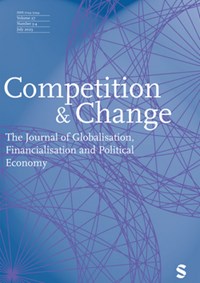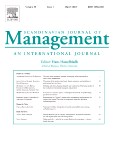Publications

This article analyses an overlooked financial instrument in political economy, despite its institutionalisation having immense ramifications for European financial markets: the covered bond. Following decades of cross-continental bank lobbying led by German mortgage banks, covered bonds transformed from a ‘little-understood corner of the German bond market’ in the mid-1990s into a global multi-trillion dollar market in the years prior to the Global Financial Crisis. This article highlights that covered bonds, on the one hand, stabilise and de-risk financialised capitalism by providing credit institutions with a stable means of bank financing and collateral while providing investors with safe investment opportunities, including during periods of crisis. In addition, the expansion of covered bond markets has marginalised mortgage securitisation in much of Europe. On the other hand, covered bonds fuel household indebtedness by increasing the credit supply available for mortgage lending, which is the primary activity of contemporary banking in general and covered bond issuers in particular. The instrument can therefore be perceived as a more simple, stable and efficient instrument for household financialisation compared to the more crisis-prone residential mortgage-backed derivative.
Link to article: https://doi.org/10.1080/13563467.2023.2230545

Departing from the Regulation Approach and the concept of spatio-temporal fixes, this article analyses how different mechanisms of financialization have ameliorated and accelerated crisis-tendencies in the North European forest industry and its implications for labour, suppliers and corporate R&D. Although wood products can potentially ameliorate the climate crisis by substituting plastics, petrochemicals, polyester and various other applications from fossils, firms have been slow to advance into these higher value-added segments. Instead, under an increasingly financialized accumulation regime, innovation has been undermined through R&D downsizing while dividends have been increased to shareholders at labour’s expense. Meanwhile, amid ultra-low
interest rates, the industry’s profitability has been supported by appreciating forest assets that are increasingly treated as a new financial asset class by the financial sector. Evidently, while some mechanisms of financialization are detrimental to firms, the financialization of forests has constituted a profitability-enhancing socioecological fix (McCarthy, 2015; Ekers & Prudham, 2017) not only for financial capital (Ekers, 2019) but also for non-financial firms themselves. In the long run, however, it is highly uncertain if forest asset prices can be kept from depreciating amid the problems of profitability, weakened ecological carrying capacity, rising interest rates and strained supplier relations.
Link to article: https://journals.sagepub.com/doi/pdf/10.1177/10245294221133534
Drawing on a Gramscian Regulation Approach and Harvey’s accumulation
by dispossession thesis, this article discusses the structural and hegemonic
mechanisms of the neoliberal transformation of Sweden’s welfare sectors.
Providing new longitudinal data on welfare retrenchment, corporate governance, wealth shares, and private economic power, the article further analyzes how the transformation of the Swedish post-war universal welfare model is related to class struggle and accumulation regime change in the Swedish economy. Following a decade-long countermobilization of Swedish capital and a severe economic crisis in the early 1990s, neoliberal economic common sense was cemented among social democratic policy elites that manifested itself in an institutionalized austerity polity, leading to a slow but steady dismantling of the Swedish welfare project. Roughly a fifth of employees in the three largest welfare sectors work in private welfare companies that generate tax-financed profits on politically created welfare markets. Welfare profits are in turn defended by a welfare–industrial complex and undergirded by a hegemonic bloc consisting of capital elites and sympathetic policymakers. In the virtual absence of vocal antihegemonic forces, many social democratic leaders have limited criticism against welfare profits throughout the last decades. On the contrary, austerity measures practiced by Swedish social democrats have thereto led to deteriorating social cohesion and spawned distrust among core social democratic voters.
Link to article: https://journals.sagepub.com/doi/pdf/10.1177/03098168221128101

Om kapitlet:
”Från 1980-talet fram till idag har den svenska välfärdsmodellen genomgått omfattande förändringar. Stora nedskärningar ar präglat den offentliga sektorn, välfärdstjänster har privatiserats och det privata näringslivets omfattning har ökat i förhållande till den offentliga sektorn. Välfärdssektorns omvandling är exempel på och resultat av de övergripande förändringar som skett i styrkeförhållandet mellan privat och offentlig sektor, där den privata kapitalmakten ökat sitt inflytande i samhället i stort.”
Om volymen:
”Hur ser det svenska samhället ut på tröskeln till 2020-talet? Den frågan ställdes till ett 40-tal forskare och utredare och svaret är ett allt hårdare klassamhälle. Sverige är idag det europeiska land med de snabbast växande klyftorna, den svårast privatiserade välfärdsstaten och där klass allt tydligare dömer människor till olika levnadsstandard, livslängd och liv. I denna bok ges statistiska bevis för klassamhällets existens i råa data från Statistiska centralbyrån. Här skildras klassamhällets förändring, med kön och etnicitet som en given dimension för förståelsen. Här visas de skilda världar i ägande, makt och inflytande över så olika delar av samhället som brottslighet, folkhälsa, mediemakt, företagsägande och anställningsskydd.”
Allelin, Majsa, Markus Kallifatides, Stefan Sjöberg, & Viktor Skyrman (2021). Välfärdsmodellens omvandling – Det privata kapitalets utvidgning i den offentliga sektorn, i Daniel Suhonen, Göran Therborn & Jesper Weithz (red.), Klass i Sverige. Ojämlikheten, makten och politiken i det 21:a århundradet, Arkiv, ss. 147-179.
Boken kan beställas här: https://arkiv.nu/butik/klass-i-sverige/

Om kapitlet:
”När frågan om ekonomisk demokrati under 1980-talet avfördes från samhällsagendan avstannade även den samhällsvetenskapliga forsningen på området. Under den tid från 1980-talet fram till idag har en omfattande omfördelning av makt och resurser från offentlig till privat sektor genomförts, och ägande-, förmögenhets- och maktkoncentrationen har både förstärkts och ändrat karaktär.”
Om volymen:
”Hur ser det svenska samhället ut på tröskeln till 2020-talet? Den frågan ställdes till ett 40-tal forskare och utredare och svaret är ett allt hårdare klassamhälle. Sverige är idag det
europeiska land med de snabbast växande klyftorna, den svårast privatiserade välfärdsstaten och där klass allt tydligare dömer människor till olika levnadsstandard, livslängd och liv. I denna bok ges statistiska bevis för klassamhällets existens i råa data från Statistiska centralbyrån. Här skildras klassamhällets förändring, med kön och etnicitet som en given dimension för förståelsen. Här visas de skilda världar i ägande, makt och inflytande över så olika delar av samhället som brottslighet, folkhälsa, mediemakt, företagsägande och anställningsskydd.”
Allelin, Majsa, Markus Kallifatides, Stefan Sjöberg & Viktor Skyrman (2021). Ägande- och förmögenhetsstrukturen och dess förändring sedan 1980, i Daniel Suhonen, Göran Therborn & Jesper Weithz (red.), Klass i Sverige. Ojämlikheten, makten och politiken i det 21:a århundradet, Arkiv, ss. 615-640.
Boken kan beställas här: https://arkiv.nu/butik/klass-i-sverige/

Abstract
This sensemaking reading of research literature identifies and seeks insight from five concepts through which the role of non-profit boards in innovation may be theorised and enacted: efficiency, external context, internal context, board structure and board processes. These concepts emanate from making sense of fifty-one publications on non-profit organisations, boards, and innovation. The concepts are subsequently translated into reflexive questions, which may guide both practitioners and future participatory action research efforts, thus, adding to a field that appears to be dominated by nonaction-based research and underdeveloped notions of innovation itself. In doing so, we move toward adopting a behavioural approach to board practices and we highlight the need for sharpened conceptualization of the very notion of innovation.
Keywords: board behaviour, innovation, non-profit organizations, sensemaking,
reading
Download: Boards and Innovation in non-profit organizations_A Sense-Making Reading.pdf (pdf)

Abstract
The purpose of this study is to explore roles and behaviour of boards governing innovation in civil society organizations. Within a qualitative and interactive action research project we worked together with two boards in Swedish civil society organizations by observing board meetings over two years. In order to gain new insights, theoretically grounded observations were continuously reflected upon together with the boards. From the observed cases, we found that boards enact controlling, service and strategizing roles out of individual experiences and unstated norms. The lack of conscious deliberation about what needs to be done and how to do it, restrains the board from functioning as a team for innovation. In conclusion, board behaviour appears shaped by institutional logics of both member movements and a marketized civil society and the way in which the boards handle this tension shape how they work for innovation. The study provides empirical observations of the understudied actual board work in civil society organizations and its prospects and problems with regards to innovation.
Keywords: boards, board work, innovation, civil society, interactive
research

About the book:
“Crumbling social institutions, disintegrating structures, and a profound sense of uncertainty are the signs of our time. In this book, this contemporary crisis is explored and illuminated, providing narratives that suggest how the notion of hope can be leveraged to create powerful methods of organizing for the future. Chapters first consider theoretical and philosophical perspectives on hopeful organizing, followed by both empirical discussions about achieving change and more imaginative narratives of alternative and utopian futures, including an exploration of the differing roles of work, creativity, idealism, inclusivity and activism.”
About the chapter:
“In the transformation to post-capitalism, money must be invested in something other than commodities, and the “return on investment” must be something other than more money. And weapons must be used to create something other than more power. Both would have to be an expression of self-limitation on the part of the strong. In this chapter, I propose that one seed for this (r)evolution is in decent supply in many high-income nations’ middle classes; with substantial collective holdings of financial capital (money), democratic states and NGOs already in place to manage it, and better-than-ever knowledge of conditions of the social and natural world, as well as a prolonged experience of meaninglessness and its corollary cynicism, the urban middle classes may well, once again, come to serve as the avant-garde of the global proletariat and the global peasantry.”
Follow this link to get the book from the publisher: Edward Elgar

Most studies of Swedish political economy are too optimistic about the condition and prospects of the reformed Swedish model (e.g. Bergh, 2014; Steinmo, 2010). Indeed, the Swedish economy has responded to the global financial crisis (GFC) in what appears to be a successful manner.
This comparativist literature nevertheless omits in-depth analysis of the impact of financialisation, partly due to its neglect of long-term, dialectical processes of change (cf. Ogden et al., 2014). There is a small literature on financialisation in Sweden (e.g. Belfrage, 2008; Forslund, 2008; Kallifatides et al., 2010; Ryner, 2013; Belfrage, 2015; Andersson and Jonung, 2015; Kallifatides, 2016). However, it has not clarified what the dynamics, contradictions and crisis-tendencies of the resulting finance-dominated accumulation regime in Sweden are. Drawing on document analysis and statistics, and based on Regulation Theory (e.g. Aglietta, 1979), this paper does just that. It thus corrects an overly idealised picture of Swedish economy and society, as well as, more broadly, holding the Swedish case up as a critical case study for the sustainability of the finance-dominated growth regime in Europe.
We argue that there is a looming crisis in the Swedish economy today, as the acceleration of financialisation following the GFC is shifting the economy away from being export-led to becoming debt-led and asset-based, and thus moving the economy closer to the UK and US economies. As such, the Swedish case suggests that the finance-dominated growth regime may be unsustainable in Europe more generally.
Read the article in full text: https://academic.oup.com/cje/advance-article/doi/10.1093/cje/bex089/4827895

This article explores the prospects of stabilising financialisation in Europe as a spatial-temporal fix for Anglo-American capitalism’s crisis-tendencies. We analyse the politics of (countercyclical) macroprudential regulation in the critical case study of Sweden. Here, macroprudential regulation is introduced, in contrast with much of the rest of the EU economies, in a credit boom.
We find evidence of an administrative crisis, as technocrats face the political constraints on re-regulating financialised accumulation. This suggests that the conditions are ripe for a deepened administrative crisis in Europe once countercyclical macroprudential regulation is implemented.
The article in full text: http://journals.sagepub.com/doi/abs/10.1177/0308518X17750877

About the book:
The main contribution of this book is empirical. The three studies included all contribute to the relatively limited extant evidence on the governance role played by different classes of institutional investors in a market characterized by shareholder-oriented governance, such as the Swedish one, in particular by considering the role of the shareholder-constituted nomination committee. The first study shows how the domestic traditional institutional investors active on the Swedish market have had an impact on the governance of listed firms by demonstrating that their involvement in the nomination committees are related to subsequent increases in the proportion of women directors. The second study shows how activist hedge funds also engage, but that the end result of their involvement in investee firms tend to be a takeover. The third study, meanwhile, suggests that foreign traditional institutional investors appear more disinclined to engage in governance matters, as evidenced e.g. by their reluctance to participate in the nomination committees of listed firms. As such, there appear to be clear differences in the level of governance engagement between classes of institutional investors as well as the firm-level effects of this engagement.
Mikael Ehne pursued doctoral studies at the Stockholm School of Economics from the end of 2013 until April 2018 when he passed away. Mikael’s conscientious work on the importance and role of institutional investors in Swedish corporate governance had come a long way and was the object of final revisions with the supervisory committee. In line with the express will of his immediate family, his manuscript for a dissertation is now published posthumously.

Sustainable development has a long history with many different roots. The most widely agreed upon definition, ‘development that meets the needs of the present without compromising the ability of future generations to meet their own needs’, includes the three main pillars of economic growth, environmental protection and social equality. Recognizing the tradeoffs and the difficulties in operationalizing the definition, the different chapters in this volume reflect different aspects of the pillars. The twelve chapters, illustrating different roots in research on sustainable development and business, can all be connected to an interpretation of the seminal modern definition.
What if economic growth is inherently unsustainable? What if economic growth, as hitherto defined, is not possible while respecting planetary boundaries and the social capacity of human beings? And what if further economic growth is not achievable under any circumstances, at least in the affluent parts of the world? Moreover, as many sustainability researchers have posited, there may be inherent conflict between development in the socioeconomic and natural worlds.
We do not claim to know exactly how to answer these observations from the outset. However, we do claim that in our times it would seem wise to maintain an open mind about most things, including how the production of goods and services for human consumption may be organized while leaving the planet in (at least) habitable condition for future generations. ‘Business as usual’ in the legacy of Adam Smith’s benefits of the ‘invisible hand’ may not be a wise choice in a world of refugee crises, climate change, biodiversity loss and persistent poverty among a growing world population. We suggest that ultimately neither ‘citizenship as usual’ nor ‘research as usual’ are viable options.

Boken är del av ett övergripande försök att med en kollaborativ forskningsansats skapa fördjupad insikt och breddad kunskap kring vitala delar i det som över tid skapats inom ramen för vad vi kan kalla ”Den svenska modellen”, nämligen de partsgemensamma pensions- och försäkringsrörelserna i AFA Försäkring, AMF och Alecta.
”Parternas bolag –ett diskussionsunderlag” är tänkt att utgöra grund för vidare diskussioner/offentlig debatt under en längre tid framåt. Här redovisas 27 längre djupintervjuer som genomförts med ledande bolagstjänstemän, styrelseledamöter och erfarna huvudmannaföreträdare. EU-direktiv, statliga utredningar, årsredovisningar, remissvar i stor mängd har också studerats. En genomgång av statsvetenskaplig, nationalekonomisk och organisationsteoretisk litteratur av omedelbar relevans för fenomenet presenteras också.
I boken diskuteras den kanske allra mest grundläggande frågan om varför arbetsmarknadens parter skall bedriva gemensam bolagsstyrning i pensions- och försäkringsrörelser. Därutöver fokuseras på ett antal centrala spänningar eller utmaningar inom ramen för dessa komplexa samverkansrelationer: möten mellan åtskilda institutionella logiker, spänning mellan expertis och representation, och avvägningar mellan att kontrollera och att stödja exekutiv ledning för operativa verksamheter i bolagsform.

Rethinking Corporate Governance’s extensive and insightful empirical investigation offers a radically new approach to corporate governance. This ground-breaking volume describes and analyses the key nature-based and actor-based forces that ultimately determine corporate governance processes and long-term corporate paths. Generally, such forces work in complex and intricate interplays that to a large extent vary among corporations.
A theory of shareholder governance is developed and integrated into the established – and more comprehensive – theory of corporate governance to create a revised theory of the corporation (firm). The new possibilities that this creates for explaining how processes develop and ultimately influence corporate paths are presented in depth. Featuring conclusions based on an empirical material that is both rich and exclusive, the book also contains extensive non- anonymized materials from authentic corporate governance processes. A general conclusion is that actions taken by individuals have a special status among those forces, as they not only generate impact in themselves, but also involve interpretations of the possible effects of all the other forces. Among those actions, the ones taken by the shareholders stand out as particularly decisive both for the governance processes as such and for how corporations develop over time.
Offering a degree of openness, detail and realism that is hard to find in any other case-based study, this innovative and enlightening volume is essential for both academics and practitioners involved in corporate governance, corporate strategy and the theory of the firm.
To place an order go to:
www-e-elgar.com

In this volume the authors describe how corporate governance takes place in practice in large Nordic companies. The empirical results and conclusions are based on an extensive in-depth study of 36 mid- and large cap corporations involving some 250 owners, board members (including Chairs), and CEOs. Three major conclusions can be drawn from the rich material.
Firstly, the authors show that a company’s total ownership situation to a large extent determines how the governance process is organized and executed. The ownership dimension that matters most is its structure (concentrated or fragmented shareholding). However, whether a corporation is owned privately or by the state also matters, as does the personality of the controlling/main owner (e.g., risk seeker or risk averse) and the owner’s personal involvement in the operational and financial flows (i.e., contribution to the different corporate bodies). All those governance qualities are crucial in the Nordic environment, where most corporations tend to have controlling/main shareholders.
Secondly, it is obvious that each corporation has the opportunity to ‘tailor’ its own governance process and that the owners actually also use that possibility. Such an option exists because the Nordic Company Laws allow considerable degrees of freedom in terms of interpretation, and the complementary soft regulations are not binding.
Thirdly, the empirical material in this extensive study lends support to the notion that what is really decisive for how the different corporations develop over time is how ownership control is captured, organized and executed. Thus, of particular importance is which owners control a company and how they act, that is, what ideas, competences, time horizons and ways of thinking dominate the governance process.
Abstract
This paper focuses on the domestic institutional investors’ ability to refocus their investments strategy in the direction of more of long-term committed capital. Suggesting a reconceptualization of domestic institutions in the sense that they can leverage on information asymmetries connected to home bias, we take an institutional approach to domestic investor rationale. We conduct qualitative and descriptive research to illuminate how Swedish institutions relate to expectations to engage in investee companies. The detected more focused investment strategies can primarily be explained through a (i) refocusing of risk-allocation mandates related to longer investments horizons, (ii) leveraging on home bias, and (iii) an owner-friendly governance model. By highlighting the embedded character of domestic institutions’ engagement, our research complements conventional ideas on institutional investors’ rational disinterest in engagement. With new norms, behavior changes.
Keywords: Corporate Governance, Institutional Investors, Long-Termism, Portfolio Allocation Models, Home Bias, Nomination Committee
JEL Classification: G, M
Read the article: https://papers.ssrn.com/sol3/papers.cfm?abstract_id=3058897
Abstract
This article presents the main ideas in the 2017 revised Ownership Policy of the Swedish Shareholders’ Association, Sveriges Aktiesparares Riksförbund (SARF). With a membership of 70,000 individual shareholders, SARF is the largest non-profit private investor organisation in Europe, and an active member of organisations such as Better Finance and the World Federation of Investors (WFI). SARF wrote the first Swedish ownership policy addressing listed companies in 1993. This is the organizations fifth ownership policy.
The text focuses in particular on six issues where change is desired:
(i) The need to make Swedish self-regulation more accessible to smaller individual shareholders.
(ii) A clear stand against general mandates for the board to decide on rights issues of cash without first offering all shareholders a right to participate;
(iii) Amendments to the Swedish companies act, AKTIEBOLAGSLAGEN to clarify that the board’s primary mission is to create sustainable profits.
(iv) That the members of the Swedish version of the external and shareholder led nomination committee to suggest independent directors to the board, is elected at the AGM.
(v) Enhanced status of independent non-executive directors that are independent of both the company and larger shareholders.
(vi) Clearer alignment of the Swedish takeover rules with both domestic regulations and regulations applicable in other European countries.
Ägarboken (the Ownership Book) (2017) covers in all more than 200 ideas and recommendations that can be summarized into 37 clear suggestions. SARF’s opinions should be of interest to a broader European shareholding public. Across Europe there is an on-going discussion among policy-setters and academics related to different ways to enhance shareholder engagement, especially of institutional investors, manifested by i.e. the Kay Review (2012). On the Stockholm Stock Exchange (SSE), also known as Nasdaq Stockholm, domestic institutional investors are in general more engaged in corporate governance than elsewhere in Europe. However, as shown in this article, the role of the individual small investor community receives less attention.
The article includes comments related to the Swedish institutional framework from both a historical and theoretical perspective. This highlights the importance of including particular features of a national governance framework when developing protective measures for individual European shareholders, that frequently act as small investors in domestic markets.
Keywords: minority shareholders, corporate governance, shareholder rights
Read the article: http://ssrn.com/abstract=3059647

Beställ boken här/Order the book here
I den här skriften redovisar författarna hur bolagsstyrningen faktiskt går till i Sverige och de övriga nordiska länderna. Av materialet framgår särskilt två saker tydligt.
Först och främst visar författarna att ägarsituationerna i hög grad avgör hur bolagsstyrningen utformas och genomförs i de enskilda företagen. Det som då främst får genomslag är ägarstrukturen (koncentrerad eller spridd), ägarkategorin (privat eller statligt), ägarpersonligheten (risksökande/riskundvikande) och ägarengagemanget (insatserna i bolagsorganen).
Av studien framgår också att företagen har mycket stora möjligheter att ”skräddarsy” egna lösningar på området bolagsstyrning, dels eftersom aktiebolagslagarna i Norden främst är inriktade på att kodifiera ägarnas starka position, dels eftersom många av de övriga regler och normer som existerar på området och som förväntas påverka hur ägarmakten utövas saknar kraftfulla sanktioner.
I denna studie blir det tydligt att något som också är verkligt avgörande för hur de olika bolagen utvecklas över tiden är hur ägarmakten erövras, organiseras och praktiseras. Det är således särskilt viktigt vilka slags ägare som är aktiva i bolagen, dvs vilka idéer, kompetenser, tidshorisonter och tänkesätt som dominerar i styrprocesserna.

Permanent link to this document: http://dx.doi.org/10.1108/CG-08-2015-0111
This article offers a political perspective on modifications in corporate governance regulation. In the wake of the financial crisis, the investment rationale of institutional investors is being pushed away from a focus on financial market liquidity and short-term trading. From a political perspective, this modification entails consideration both of investment horizon and of the definition of corporate value.
The article narrates the historical policy debate on institutional investors as corporate governors. Building on this point, we develop a conceptual framework to further our understanding of the current shifts in policy debate of institutional investors as governors. We find a strong policy impetus to move away from certain liberal market assumptions of efficient financial markets and the positive effects of privatization, toward viewing markets as institutionally embedded.
Based on our knowledge of corporate governance regimes’ political economy, we argue that this shift brings intensified engagement of institutional investors in corporate affairs. We specify the reasons for why and how this might be politically contested. In conclusion, we offer propositions regarding the outcome of such contestation in different national corporate governance regimes.

https://www.hhs.se/sv/forskning/Institutes/institute-for-research/sir-publications/

I denna skrift diskuteras frågan om (svenska) staten skall äga företag och i så fall varför och i vilka former. Inledningsvis behandlas utförligt vad som utmärker staten som företagsägare och vilka för- respektive nackdelar som den ägarformen genererar. Avsnittet avslutas med en listning av ett antal förhållanden som påtagligt påverkar en stats utrymme att verka som företagsägare.
I ett längre avsnitt beskrivs och analyseras orsakerna och motiven till det (svenska) statliga företagsägandet. Där visas att den betydande variation som föreligger när det gäller de statliga företagens uppdrag har konsekvenser för hur den statliga företagspopulationen kan organiseras och det visas att dessa stora olikheter företagen emellan också kräver differentierad styrning.
I ett därpå följande avsnitt redogör författarna för ett antal av de vetenskapliga studier som främst fokuserar staten som företagsägare. De är i grunden av två typer: jämförande och processuella. I det första fallet handlar det om empiriska studier där forskarna försökt utreda det statliga företagsägandets (relativa) effektivitet genom att jämföra det med liknande privatdrivna verksamheter. I det andra fallet ligger fokus på de privatiseringsprocesser som uppträdde under det sena 1900-talet i främst Central- och Östeuropa.
Avslutningsvis illustrerar författarna hur en så omfattande (58 företag) och starkt diversifierad företagspopulation (alltifrån Operan/Dramaten till LKAB/Vattenfall) som den statliga skulle kunnna organiseras. Ambitionen med denna genomgång är då primärt att skapa respekt för frågans komplexitet men också att tillhandahålla några teorier och modeller som kan användas som analyshjälpmedel när omfattningen av den svenska statliga företagssektorn skall fastläggas och dess styrformer sjösättas.

http://www.bokus.com/bok/9789186949532/fientliga-bud-teorierna-maktspelet-kortsiktigheten/
Aga, Astra, Esab, Gant, Scania, Skandia, Stora, Volvo PV … listan på svenska börsbolag som köpts upp av utländska ägare eller riskkapitalister under de senaste tjugo åren kan göras lång. I en populärvetenskaplig bok som bygger på Nachemson-Ekwalls avhandling från 2012 utvecklas teorierna och mekanismerna bakom denna utveckling. Vilken roll spelar det svenska systemet för bolagsstyrning och de svenska uppköpsreglerna för möjligheterna att förvärva svenska bolag? Och vilka skillnader finns mellan Sverige och andra länder?
Boken tar sin utgångspunkt i situationer med fientliga bud, det vill säga där köparen förvärvar ett bolag i strid mot företagsledningens vilja. I två initierade fallstudier beskrivs budstriderna i livförsäkringsbolaget Skandia, som togs över av det sydafrikanskt-brittiska försäkringsbolaget Old Mutual 2005, och lastbilstillverkaren Scania, som åren kring 2006-2012, drogs in i en infekterad budstrid med de tyska fordonstillverkarna MAN och VW.
Författaren pekar på att dagens öppna kapitalmarknader, stora inslag av institutionellt ägande, den svenska aktieägarorienteringen och Sveriges anpassning till olika EU-regler inte bara gjort det lättare att köpa just svenska börsbolag, utan också främjat kortsiktigt tänkande i ledning och styrning av svenska börsbolag. Aktieägarnas intresse har prioriterats framför anställda, kunder och samhälle.
Avslutningsvis ges förslag på hur bolagsstyrning och uppköpsregler i Sverige bör förändras för att återskapa börsbolagens och det svenska näringslivets förmåga till långsiktigt och hållbart värdeskapande.

What do companies do when they practise CSR? It is this very empirical question that stands in the spotlight in this book chapter. We present a study of a project that the company in question presented and publicly highlighted as an example of CSR in practice: an electrification project that ABB, a multinational company, carried out in a village in rural Tanzania.
Please find more info about the book here.

Den svenska samhällsmodellen har många dimensioner, som kan ifrågasättas, prövas, utvecklas, utforskas och omvandlas. I denna skrift presenteras ett underlag för sådana diskussioner som tar sin utgångspunkt i AFA Försäkring - en försäkringsorganisation i bolagsform, ägd av arbetsmarknadens parter - som belyses inom ramen för samhällsekonomisk teori och teori om bolagsstyrning. Kan denna bolagsmodell finna sin plats i den framväxande europeiska ekonomin? Vilka utmaningar står organisationen och dess huvudmän inför? Hur möta omgivningens krav?

Link: http://www.diva-portal.org/smash/record.jsf?searchId=1&pid=diva2:566226
Taking a sociological perspective on the market for corporate control this thesis calls into question financial capitalism with its preference for clear shareholder-value governance of the corporation. The institutional setting chosen to show this is Sweden, with its particularly shareholder friendly governance regime and its very active takeover market. To this is added three longitudinal case studies of cross-border hostile takeover processes during the sixth takeover wave in Europe.
These reveal that the success of cross-border hostile bids has little to do with the theory of the market for corporate control, as a market where contests enable "good managers" to win over "bad managers", with the overarching goal of enhancing wealth creation for society at large. Instead the most successful actors on a market for corporate control are those who best understand that market's power dynamics - including the use of regulatory and moral arbitrage between different national frameworks and the leveraging of short-termism of institutional investors.
The case studies are then analyzed in relation to the revised Swedish takeover rules of 2009. This shows that the revision did not address the problems detected, focusing instead on enhancing deal making and further limiting the board's ability to work for long term value creation. As a whole this thesis calls for a development of a theory of a market for corporate control that in a more sustainable way will enable board of directors to focus on the corporation as value accretive entity.

Link: http://www.diva-portal.org/smash/record.jsf?searchId=1&pid=diva2:566049
The study builds on the belief that change has become a normal state of affairs in business life, and that one highly contemporary actor - the private equity firm - has evolved to become specialized in change through repetitively changing its portfolio firms in its quest to generate value. The quest of reshaping a portfolio firm in order to optimize its strategic position, profitability, and financial structure in order to generate value has consequently been this study's starting point.
This dissertation presents how sense making, which is about the interplay of action and interpretation, changes over time and how it affects the strategic change of a portfolio firm. By studying and directly observing the communication and interaction between the portfolio firms's CEO, board, and management team in real-time during a prolonged period when change occurs at a revolutionary pace, this dissertation seeks to examine the development and influence of this sense making.
The study demonstrates how certain traits of private equity firms influence the timeline, risk profile, and governance of strategic change, how the presence of an idiosyncratic language influences the strategic change by transcending one mindset into a diametrically opposed ditto, and how the materialization of a mental iron cage affects the boundaries of the potential changes as well as adaptations and worldviews.

DOI: 10.1016/j.scaman.2010.11.002
The purpose of the article is to elaborate a position in debates on management teaching by properly remembering the origins of the agency theory of the firm. In a speculative piece, the precise role of agency theory in ongoing global financial crisis is conceptualized as carrier of hyper-ideological (un)consciousness.

Kapitalismen har gått in i en ny fas - den finanskapitalistiska eran. Där dominerar de aktörer som hanterar kapitalets allokering över dem som engagerar sig i hur verksamheterna som sådana bäst kan utvecklas. Ofta förefaller det dessutom vara de kortsiktiga finansiella aktörerna som avgör vad som sker i och med företagen över tiden. Detta innebär en påtaglig risk för att tillgången på aktörer som försöker bygga uthålliga värdeskapande strukturer begränsas. På sikt riskerar en sådan utarmning av ägarfunktionen att hota de många människornas välfärd.
I detta kapitel diskuterar vi möjligheterna för främst de stora noterade företagen att bygga uthålliga värdeskapande strukturer på den alltmer globaliserade kapitalmarknad som växt fram under de senaste årtiondenas finanskapitalism. Finansiellt sparande som förvaltas via mellanhänder har gett upphov till en radikalt förändrad aktieägarbild, samtidigt som både regelverk för bolagsstyrning och andra normer "vandrar" över nationsgränser. Vi intresserar oss särskilt för hur denna omvandling av kapitalmarknaden påverkat hur företagen styrs (jämför begreppet corporate governances)

Order from: direct.order@marston.co.uk
http://www.elgaronline.com/abstract/9781848446847.xml
This insightful book focuses upon corporate governance processes, and explores the conditions required for effective corporate governance and control in 21st century globalized and financialized economies. In presenting a comprehensive study of a cross-border hostile corporate take-over process, describing the actors, institutions and events involved, this book examines and questions the current forms of corporate governance and control - both from a national and a global perspective. Using Old Mutual's takeover of Skandia as a case study, the authors address corporate governance theory, and highlight its two fundamental dimensions: financial and operational flows.
An important conclusion of the book is that the motives and theories of contemporary financial markets appear to have gained in importance at the expense of the corresponding operational considerations, something that has dramatically changed the rationales of different types of actors. The book critically questions these transformations, calling for the reconsideration and redesign of regulating institutions and corporate governance processes.
This critical investigation of the competition for corporate control in the era of modern financial capitalism will prove a fascinating read for students, academics and researchers in the fields of corporate governance, finance and international business. It will also appeal to policymakers and practitioners within the realms of corporate finance, banking and the wider financial services industry.
This book can be ordered from Marston Book Services Ltd: www.marston.co.uk or from Edward Elgar +44 1235 465 500. Email: info@e-elgar.co.uk

"If governments, NGOs, and corporations really cared, CSR would not be the solution, no matter how pompous and serious we parade as being." (p. 196)
Please find more information here.

Order it: publications@hhs.se
Hur går det egentligen till när styrelser utses i stora svenska företag? Vilka slags personer, kompetenser och erfarenheter efterfrågas - och varför? Varför finns det så få kvinnor i företagsstyrelserna i Sverige? Har det skett någon internationalisering av svenska bolagsstyrelser - och i så fall i vilken utsträckning och med vilka motiv? Och har tillkomsten av nomineringskommittéer inneburit någon verklig förändring av hur det stora bolagens styrelser sätts samman?
Författarna har genomfört en studie av hur rekryteringsprocesser ser ut i svenska storföretag. Det empiriska materialet omfattar - utöver statistiska uppgifter - bland annat trettio ingående intervjuer och nästan lika många kortare uppföljningsintervjuer med styrelseordföranden, styrelseledamöter, medlemmar i nomineringskommittéer, ägare och ägarrepresentanter, verkställande direktörer, styrelseledamöter och rekryteringskonsulter.
Boken inleds med en genomgång av grundläggande fakta kring styrelsers ställning och då särskilt i relation till ägare, revisorer och verkställande direktörer. Vidare beskrivs en styrelses huvudsakliga uppgifter, ansvar och arbetsformer. Skriftens fokus ligger dock på hur styrelser rekryteras och sammansätts - både på själva den process där de enskilda ledamöterna vaskas fram - nominreingskommittéernas arbete - och på hur ett effektivt samarbete mellan ledamöter kan åstadkommas.
En av de viktigare slutsatserna från studien är att det förefaller vara en väsentlig skillnad mellan rollen som verkställande direktör och uppdraget som styrelseledamot - en skillnad som länge varit underskattad. Denna slutsats öppnar för en breddning av vilka erfarenheter och komptetnser som betraktas som värdefulla - och därmed utvidgas mängden av potentiella ledamöter.

Read the full story
“Froud, Johal, Leaver and Williams’s book contains three extended case studies of the ways in which narratives of corporate strategy, finely subdivided into firm, industry and grand economic stories, are reflexively related to accounting numbers and circulated among corporate managers, analysts, consulting firms and best-selling authors of how-to management books. All this takes place in an economy in which the stock-market has become an object of interest to large strata of society, slowly but surely turning the attention of almost everybody towards day-to-day movements in share prices.”
https://www.tandfonline.com/doi/full/10.1080/17405900902750096